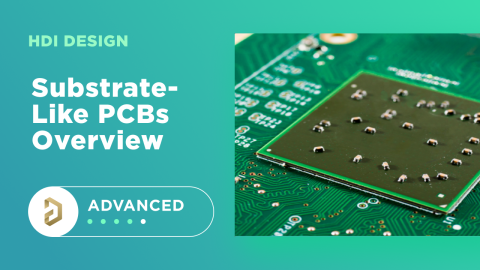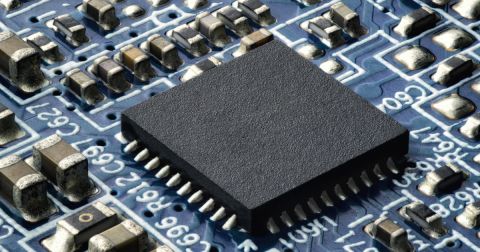UHDI Pushes PCB Feature Size Miniaturization to Its Limit

Whether we are ready for it or not, miniaturization of electronic packages is barreling ahead challenging PCB designers, PCB fabricators and PCB assemblers. In this blog, we are going to examine some of the complexities of miniaturization using the SMTA Ultra-HDI Assembly Test Board for navigation.
Deconstructing the Past
As it was 7 years ago when the previous version SMTA Assembly Test Board was developed, this new version is a strong tool for PCB assemblers to use when analyzing process parameters to meet these miniaturization needs. Scrutinizing the existing SMTA assembly test board, it became evident that certain components, once considered cutting-edge, have now become mainstream. An SMTA test board design by Chrys Shea can be found below; you can learn more at her website.

To pave the way for innovation, the Ultra HDI assembly test board design has bid farewell to these components, making room for the next generation. Components like the 0.5 mm pitch area array discrete components sizes 0402 (1005M), while still relatively new to more conservative designs, have transitioned into everyday use for many assemblers. A huge variety of experiments over the years have helped develop guidelines for footprints, stencil designs and board layout for components on this scale; now it’s time to focus on the next level of miniaturization challenges.
Embracing the Future
The good news is that the smallest electronic component - the 008004 (0201M) capacitor has not gotten any smaller. The bad news is that the larger components - the grid arrays and bottom terminated components – have gotten smaller and more complicated.

008004 capacitor feature size comparison.
Smaller packages are always in demand because they not only represent real estate reduction on a PCB; they also often represent a cost reduction. As the smaller packages get adopted into designs and their popularity grows, they displace their larger predecessors, which then become more expensive and eventually obsolete. It’s not uncommon for the supply chain dynamics to force designs that do not necessarily need miniaturization into implementing it.
The Challenge of Selection
Choosing the components for the redesigned test board wasn't just about embracing the latest technologies—it was about navigating the challenges they present. Miniaturization brings with it a unique set of hurdles for PCB assemblers, from ensuring proper soldering in high density areas to addressing design-related issues that appear during scale-up.
The selection process was not only about component size, but also location, rotation, pad layout, thermal relief, and other considerations that are typically encountered on the SMT line.
Some of the new test features include:
- Tombstone Alley
One standout feature on the redesigned board is what is affectionately call "Tombstone Alley." Tombstoning, where a component stands upright on one end during reflow, is a common challenge in miniaturized assembly. Tombstone Alley is a dedicated area on the test board strategically designed to test and address tombstoning issues. It allows us to explore innovative solutions and refine our assembly techniques to mitigate this challenge effectively. Add link to tombstoning blog here. - The Leading Edge Effect
The solder paste deposits on the PCB pads that are the first to get printed are usually a lot less repeatable than the others on the board. The effect happens in both print directions. The smaller the pads and the more tightly they are packed, the more prevalent the effect. The Leading Edge test will enable assemblers to assess the effects of component location and learn how to address it. - Off-Axis Placement
The days of only having 0, 90, 180 or 270 degree orientations are long gone. Fitting all the needed components into a particular form factor now requires placements at 30, 45, or 60 degree - or even custom - angles. This can present challenges to placement and inspection. Components sized from 0201 (0603M) to 008004 (0201M) are placed in traditional orientations as well as typical off-axis angles to test machine capabilities. - Illuminating Insights with LEDs:
Another exciting addition to the test board is the incorporation of LEDs into the patterns of discrete components. While a seemingly small and simple addition, they serve multiple purposes.- First, they perform an in-circuit test function: if all 25 components are soldered correctly, they illuminate.
- Second, they provide an inspection and troubleshooting function: if the LEDs do not illuminate, the assembler can inspect 50 solder joints to find the defect.
- Third, they act as a rework training aid. If properly reworked, the lights will illuminate.
Miniaturized devices bring with them a new set of challenges for rework. The LEDs add a dynamic and interactive element to the testing process, enhancing practicality and educational value.
In a future blog we will dive into ultra-HDI fabrication and more specifically how the various ultra-HDI fabrication techniques can improve yield with not only PCB trace and space, but also with these tight pitch pads. The industry as a whole is going through a steep learning curve and printed circuit board fabricators and printed circuit board assemblers are navigating this learning curve to ultimately provide design guidelines for printed circuit board designers.
To learn more about the SMTA Ultra HDI Assembly Test Board, listen in on this OnTrack Podcast with Zach Peterson and Chrys Shea.










